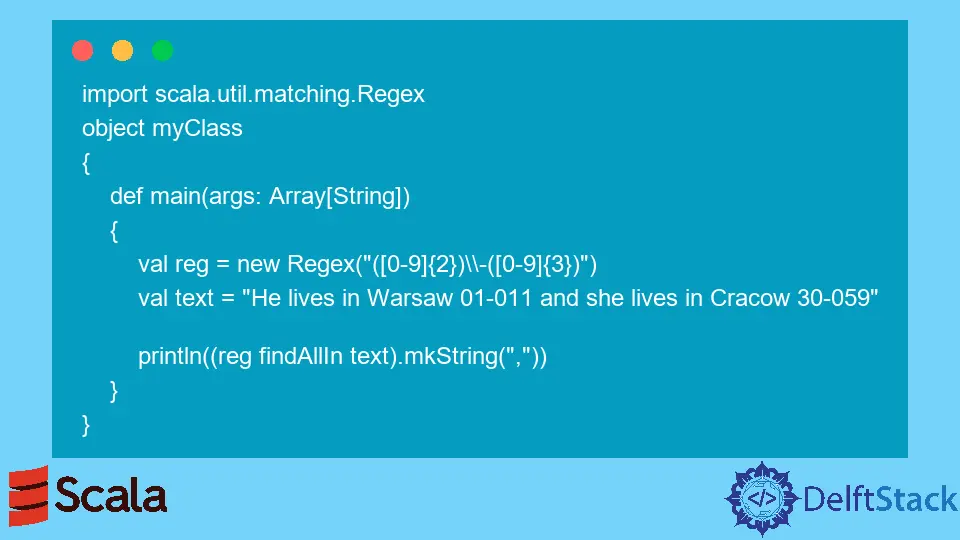在 Scala 中使用正規表示式

正規表示式定義了用於匹配輸入資料的通用模式。這些對於模式匹配和文字處理或解析非常有用。
在本文中,我們將學習如何在 Scala 中使用 Regex(正規表示式)。
Scala 中的 Regex 類
Regex 是 Scala 中的一個類,它是從 scala.util.matching.Regex 匯入的,基於 Java 包 java.util.regex,廣泛用於模式匹配和文字解析。Regex 物件可以通過兩種方式建立。
第一種方法是顯式建立 Regex 類物件。
val x = new Regex("you")
第二種方法是使用 r 方法。
val x = "You".r
讓我們看一下使用 Regex 的正規表示式的不同用例。
在 Scala 中查詢文字中的匹配項
在文字中查詢匹配項是 Regex 最常見的用例之一。
示例程式碼:
import scala.util.matching.Regex
object myClass
{
def main(args: Array[String])
{
val x = new Regex("Tony")
val text = "Iron man is also known as Tony Stark. Tony is an Avenger"
println(x findFirstIn text)
}
}
輸出:
Some(Tony)
在上面的程式碼中,我們使用了 findFirstIn 方法來查詢正規表示式的第一個匹配項,該方法返回一個 Option[String] 物件。
示例程式碼:
import scala.util.matching.Regex
object myClass
{
def main(args: Array[String])
{
val reg = new Regex("([0-9]{2})\\-([0-9]{3})")
val text = "He lives in Warsaw 01-011 and she lives in Cracow 30-059"
println((reg findAllIn text).mkString(","))
}
}
輸出:
01-011,30-059
在上面的示例中,我們使用 findAllIn 方法查詢所有匹配項並返回 MatchIterator。然後我們使用 mkString 方法將輸出轉換為由 ,(逗號)分隔的字串。
我們還有 findFirstMatchIn 方法。它的工作方式類似於 findFirstIn 方法,但返回 Option[Match]。
示例程式碼:
import scala.util.matching.Regex
object myClass
{
def main(args: Array[String])
{
val reg = new Regex("([0-9]{2})\\-([0-9]{3})")
val text = "He lives in Warsaw 01-011 and she lives in Cracow 30-059"
val result = reg.findFirstMatchIn(text)
println(Some("011"), for (x <- result) yield x.group(2))
}
}
輸出:
(Some(011),Some(011))
使用 Regex 替換 Scala 中的文字
這是替換文字的 Regex 的另一個用例。有時在文字解析期間,我們可能已經用其他東西替換了其中的一部分。
示例程式碼:
import scala.util.matching.Regex
object myClass
{
// Main method
def main(args: Array[String])
{
val reg = new Regex("([0-9]{2})\\-([0-9]{3})")
val text = "He lives in Warsaw 01-011 and she lives in Cracow 30-059"
println(reg replaceFirstIn(text, "1234"))
}
}
輸出:
He lives in Warsaw 1234 and she lives in Cracow 30-059
在上面的程式碼中,我們使用了 replaceFirstIn 方法將文字中找到的第一個匹配項替換為字串 "1234"。
示例程式碼:
import scala.util.matching.Regex
object myClass
{
// Main method
def main(args: Array[String])
{
val reg = new Regex("([0-9]{2})\\-([0-9]{3})")
val text = "He lives in Warsaw 01-011 and she lives in Cracow 30-059"
println(reg replaceAllIn(text, "1234"))
}
}
輸出:
He lives in Warsaw 1234 and she lives in Cracow 1234
在上面的程式碼中,我們使用了 replaceAllIn 方法,它將在文字中找到的所有匹配項替換為 "1234"。
使用 Regex 在 Scala 中提取值
當我們使用正規表示式找到匹配項時,我們可以使用 Regex 通過模式匹配來提取值。
示例程式碼:
import scala.util.matching.Regex
object myClass {
def main(args: Array[String]) {
val timestamp = "([0-9]{2}):([0-9]{2}):([0-9]{2}).([0-9]{3})".r
val time = "12:20:01.411" match {
case timestamp(hour, minutes, _, _) => println(s"It is $minutes minutes after $hour")
}
}
}
輸出:
It is 20 minutes after 12
在 Scala 中,預設情況下,Regex 的行為就像模式是 anchored。例如,模式被放在^和 $ 字元的中間,如^pattern$,但我們可以使用 UnanchoredRegex 類中的 unanchored 方法刪除這些字元。
有了這個幫助,我們可以在字串中新增額外的文字,並且仍然可以找到我們需要的內容。
示例程式碼:
import scala.util.matching.Regex
object myClass
{
def main(args: Array[String]) {
val timestamp = "([0-9]{2}):([0-9]{2}):([0-9]{2}).([0-9]{3})".r
val temp = timestamp.unanchored
val time = "It is 12:20:01.411 in New York" match {
case temp(hour, minutes, _, _) => println(s"It is $minutes minutes after $hour")
}
}
}
輸出:
It is 20 minutes after 12
Java 從 Perl 程式語言繼承了它的大部分正規表示式和它的 Regex 特性,而 Scala 從 Java 繼承了它的正規表示式語法。
讓我們看一下從 Java 中提取的一些 Scala 常用的正規表示式。
| 子表示式 | 匹配 |
|---|---|
^ |
它匹配行的開頭。 |
$ |
它與結尾的開頭相匹配。 |
[...] |
它用於匹配括號中存在的任何單個字元。 |
[^...] |
它用於匹配括號中不存在的任何單個字元 |
\\w |
它用於匹配單詞字元。 |
\\d |
它用於匹配數字。 |
まとめ
在本文中,我們瞭解了 Scala 標準庫中的 Regex 類。我們還看到了它如何提供不同的 API,幫助我們處理正規表示式的不同用例。
